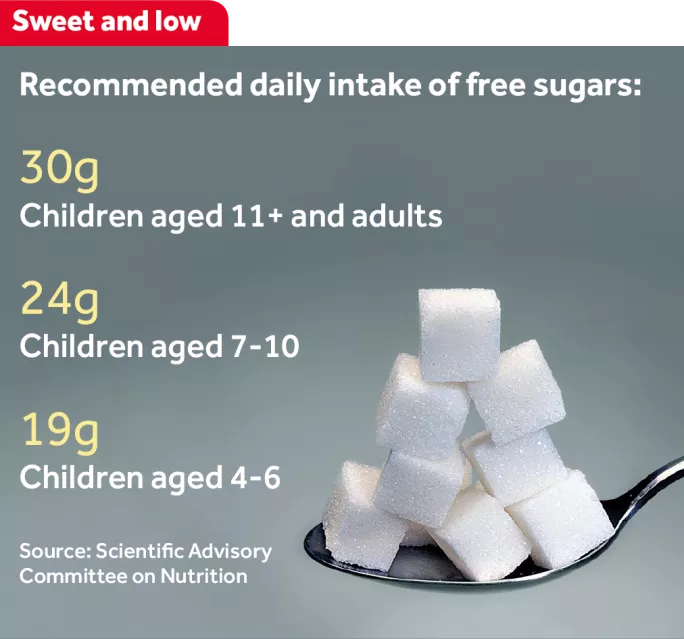Cultivating a new nostalgia for veg

Lorraine Tulloch, programme lead at Obesity Action Scotland, looks forward to a time when people will be nostalgic about school dinners because of the exciting new fruits and vegetables they were introduced to - not because of the puddings they guzzled.
“People have really fond memories of school puddings,” says Tulloch. “They talk about having things like caramel tart with custard - that’s what they remember and they don’t seem able to move on from that.”
But with children eating three times as much sugar as they should and 29 per cent of them classified as overweight or obese, we have to get over any sentimental feelings for pink custard or rice pudding, she argues.
“In 30 years, we could be reminiscing about healthier puddings or the fruit and veg,” Tulloch adds. “We could be saying: ‘I remember it was at school dinners when I tasted my first sweet potato.’ That could be the future, and that would be a great future - because it would mean we had shifted what people value.”
Tulloch stops short of calling for a pudding ban, but wants schools to stop serving pudding five days a week and to stop giving pupils the choice between soup and a dessert - research by Obesity Action Scotland last year found that this was the case in half of councils.
The research also revealed that an average school pudding contained more than three teaspoons of sugar (14g), and yogurts, while low in fat, were high in sugar, containing an average of 12.7g.
It concluded that offering such puddings at school made it “almost impossible” for children to stay within the range of their daily recommendations.
Now a Tes Scotland investigation has found that schools are being admonished by Education Scotland health and nutrition inspectors for serving: iced carrot cake containing more than 11 teaspoons of sugar; “high volumes of processed meat”; too much deep-fried food and baked goods for breakfast.
Given Scotland has relatively tough nutritional guidelines for school meals, it is hard to understand how these foods slip through the net. But Education Scotland’s process for inspecting schools to make sure they are adhering to the standards is not transparent enough, says Tulloch. She wants them to publish their findings, adding that the guidelines for school food which were introduced in 2008 have not kept pace with the latest advice. In 2015, the Scientific Advisory Committee on Nutrition advised that Britain should halve its recommended allowance of free sugars in food, in order to tackle the growing obesity and diabetes crisis.
It is also possible to have foods with high sugar content on school menus because the nutritional content of meals is averaged out across the week, Tulloch says. This can mask some very high daily sugar offerings.
“We do have some of the strictest nutritional standards in the world but that’s not translated into the best experience for children,” Tulloch explains. “We were particularly concerned about the high calorie content of some puddings, and [the fact that] puddings were served more often than soup in some local authorities - a lot of authorities offered soup or pudding as a choice. What as a child are you going to pick? As adults we might choose between a starter and a dessert but young children need to be guided in their choices.”
Tricky customers
Drawing on its research, Obesity Action Scotland has four recommendations: include fewer processed foods on menus; prioritise vegetables, soups and salads over puddings; move towards the new Scottish Dietary Goals for sugar content; and create a “positive physical and social environment” for school meals.
Tulloch adds: “At the moment, a lot of the time what [pupils] are getting is a better version of a sausage, a better version of a pizza or a better version of a chicken nugget. But that seems the wrong message to send, because when they walk out in the real world sausage and pizza will not be of the same nutritional quality, yet they will have learned that is the right thing to do.”
However, Jim Thewliss, general secretary of secondary headteachers’ organisation School Leaders Scotland, argues that schools - and in particular secondaries, where pupils can vote with their feet - cannot afford to alienate their customers.
Thewliss says: “If the school doesn’t provide deep-fried whatever, [pupils] can trot off down the road and get it there. So the people in the kitchen either respond or they cut costs further, because they don’t have the customers coming through the door. Attracting the kids to stay in school and giving them something nutritious - to get that balance right is a difficult thing to do.”
In response to the Scottish government consultation on its obesity strategy earlier this year, the Glasgow Centre for Population Health suggested pupils should be banned from leaving school to prevent them eating takeaways and junk food at lunchtime. But Thewliss dismisses this idea as “nonsense”.
He says: “In primary they see it as a safety issue - they don’t want kids wandering off and they can hold that line - but at secondary there’s not the same health and safety issue when you’re dealing with older kids.”
Tulloch acknowledges that improving school food alone will not solve the obesity crisis. She would like more cooking lessons in schools, from primary through to home economics in secondary, and believes that adverts for foods high in sugar, fat and salt should banned before 9pm.
Cafés and restaurants should also be obliged to give diners more information about the nutritional value of the food they are eating, Tulloch says, adding: “I welcome and support the commitment from the government to halve childhood obesity, but it will need bold action because we have seen the same static rates for a number of years now.”

You need a Tes subscription to read this article
Subscribe now to read this article and get other subscriber-only content:
- Unlimited access to all Tes magazine content
- Exclusive subscriber-only stories
- Award-winning email newsletters
Already a subscriber? Log in
You need a subscription to read this article
Subscribe now to read this article and get other subscriber-only content, including:
- Unlimited access to all Tes magazine content
- Exclusive subscriber-only stories
- Award-winning email newsletters